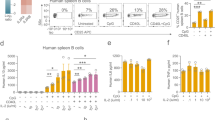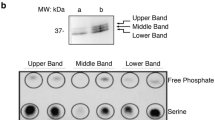Abstract
Human interleukin-2 (IL-2) is a glycoprotein of relative molecular mass (Mr) 15,000, which is released by T lymphocytes on stimulation with antigen or mitogen and functions as a T-cell growth factor (TCGF) by inducing proliferation of activated T cells1. It is generally accepted that resting or activated T cells do not respond directly to IL-2 but require for their proliferation other T-cell-derived lymphokines usually referred to as B-cell growth factors (BCGFs)2,3. Recently, however, a monoclonal antibody reacting with the IL-2 receptor molecules expressed by activated T cells (anti-Tac)4,5 was shown to react also with certain B tumour cells6; in addition, murine B cells proliferate in response to pure human IL-27. We now show that recombinant IL-2, derived from Escherichia coli expressing the human gene8, is able to promote strong proliferation of human B cells activated with protein-A-rich Staphylococcus aureus Cowans strain I2. Moreover, we demonstrate that the anti-Tac antibody also reacts with S. aureas-activated normal B cells and inhibits sharply the proliferative response of such cells to IL-2. Finally, immunoprecipitation experiments reveal that anti-Tac defines similar molecules on activated T and B cells.
This is a preview of subscription content, access via your institution
Access options
Subscribe to this journal
Receive 51 print issues and online access
$199.00 per year
only $3.90 per issue
Buy this article
- Purchase on Springer Link
- Instant access to full article PDF
Prices may be subject to local taxes which are calculated during checkout
Similar content being viewed by others
References
Smith, K. A. Immun. Rev. 51, 337–357 (1980).
Fauci, A. S., Muraguchi, A., Butler, J. L. & Kehrl, J. H. in Prog. Immun. 5, 1053–1067 (1984).
Howard, M. et al. J. exp. Med. 155, 914–923 (1982).
Leonard, W. J. et al. Nature 300, 267–269 (1982).
Leonard, W. J., Depper, J. M., Robb, R. J., Waldmann, T. A. & Greene, W. C. Proc. natn. Acad. Sci. U.S.A. 80, 6957–6961 (1983).
Korsmeyer, S. J. et al. Proc. natn. Acad. Sci. U.S.A. 80, 4522–4527 (1983).
Zubler, H. R. et al. J. exp. Med. (in the press).
Devos, R. et al. Nucleic Acids Res. 11, 4307–4322 (1983).
Muraguchi, A. & Fauci, A. S. J. Immun. 129, 1104–1108 (1982).
Mingari, M. C. et al. Eur. J. Immun. (in the press).
Kehrl, J. H., Muraguchi, A. & Fauci, A. S. J. Immun. 132, 2857–2861 (1984).
Hubbard, A. L. & Cohn, Z. A. J. Cell Biol. 64, 438–460 (1975).
Butler, J. L., Muraguchi, A., Lane, H. C. & Fauci, A. S. J. exp. Med. 157, 60–68 (1983).
Okada, M. et al. J. exp. Med. 157, 583–590 (1983).
Moretta, A. Eur. J. Immun. (in the press).
Moretta, L., Webb, S. R., Grossi, C. E., Lydyard, P. M. & Cooper, M. D. J. exp. Med. 146, 184–200 (1977).
Moretta, A., Pantaleo, G., Moretta, L., Cerottini, J.-C. & Mingari, M. C. J. exp. Med. 157, 743–754 (1983).
Malissen, B., Rebai, N., Liabeuf, A. & Mawas, C. Eur. J. Immun. 12, 739–747 (1982).
Laemmli, U. K. Nature 227, 680–685 (1970).
Author information
Authors and Affiliations
Rights and permissions
About this article
Cite this article
Mingari, M., Gerosa, F., Carra, G. et al. Human interleukin-2 promotes proliferation of activated B cells via surface receptors similar to those of activated T cells. Nature 312, 641–643 (1984). https://doi.org/10.1038/312641a0
Received:
Accepted:
Issue Date:
DOI: https://doi.org/10.1038/312641a0
This article is cited by
-
Genetically engineered mesenchymal stem cells: targeted delivery of immunomodulatory agents for tumor eradication
Cancer Gene Therapy (2020)
-
Omics-wide quantitative B-cell infiltration analyses identify GPR18 for human cancer prognosis with superiority over CD20
Communications Biology (2020)
-
Adjuvants for peptide-based cancer vaccines
Journal for ImmunoTherapy of Cancer (2016)
-
Production of Cytokine and NO by RAW 264.7 Macrophages and PBMC In Vitro Incubation with Flavonoids
Archives of Pharmacal Research (2005)
Comments
By submitting a comment you agree to abide by our Terms and Community Guidelines. If you find something abusive or that does not comply with our terms or guidelines please flag it as inappropriate.



